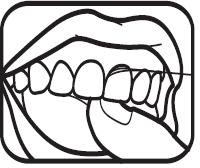How to Floss
- Use about 18 inches of floss wound around one of your middle fingers,
with the rest wound around the opposite middle finger.
- Hold the floss tightly between the thumbs and forefingers and gently insert it between
the teeth.
- Curve the floss into a “C” shape against the side of the tooth.
- Rub the floss gently up and down, keeping it pressed against the tooth.
Don’t jerk or snap the floss.
- Floss all your teeth. Don’t forget to floss behind your back teeth.









 Kennedy from Houston, TX as 2007 CuteKid of the Year!. Her family is so proud! Read what Mom has to say about her Cutie-
Kennedy from Houston, TX as 2007 CuteKid of the Year!. Her family is so proud! Read what Mom has to say about her Cutie-